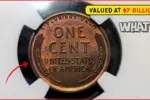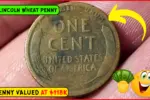The Lincoln Wheat Penny, a seemingly humble coin, has captivated the imagination of collectors, historians, and casual enthusiasts for over a century. Despite its modest origins as everyday currency, this penny has transcended its initial purpose to become a sought-after collectible. Astonishingly, some rare Lincoln Wheat Pennies have fetched values as high as $985,000, and a few may still be lurking in circulation today. Let’s explore the history, unique traits, and enduring appeal of this remarkable coin.
A Revolutionary Design: The Birth of the Lincoln Wheat Penny
The Lincoln Wheat Penny was first introduced in 1909 to commemorate the centennial of Abraham Lincoln’s birth. Designed by Victor David Brenner, it was the first U.S. coin to feature the portrait of an actual historical figure. Before this coin, American currency predominantly depicted allegorical figures representing liberty and freedom.
The obverse side of the coin showcases a detailed profile of Lincoln, exuding dignity and a sense of connection to one of America’s most revered presidents. The reverse side features two simple yet elegant wheat stalks, framing the words “One Cent” and “United States of America.” These stalks symbolize America’s agrarian roots and stand as a nod to the nation’s prosperity and potential.
The Lincoln Wheat Penny quickly became a favorite among the American public. Its widespread popularity marked a turning point in U.S. coinage design, setting a precedent for future coins to honor significant figures in American history.
Rare Specimens: The Diamonds in the Rough
What sets the Lincoln Wheat Penny apart as a collectible is the sheer variety of rare and valuable specimens within its lineage. While the majority of Lincoln Wheat Pennies are worth no more than their face value, certain coins possess unique characteristics that make them highly desirable.
The 1943 Copper Penny
Among the most legendary of these coins is the 1943 copper penny. During World War II, the U.S. Mint switched to producing pennies from zinc-coated steel to conserve copper for the war effort. However, a small number of copper planchets were inadvertently used in production, resulting in one of the rarest and most valuable coins in American history. These coins have fetched prices in the hundreds of thousands, with one example selling for over $1 million.
The 1909-S VDB Penny
The first year of production also yielded a rarity: the 1909-S VDB penny. Produced at the San Francisco Mint, these pennies include Victor David Brenner’s initials (“VDB”) on the reverse. Due to public criticism of the prominent placement of the initials, production was halted, making these pennies a collector’s dream.
Double Die Errors
Double die error pennies, where the coin’s design appears doubled due to a misalignment during the minting process, are another category of rare Lincoln Wheat Pennies. The 1955 double die obverse penny is particularly famous and highly valued by numismatists.
What Makes These Coins So Valuable?
The value of Lincoln Wheat Pennies is determined by several factors:
- Rarity: Coins produced in limited quantities or with minting errors are naturally more valuable. For example, fewer than two dozen 1943 copper pennies are believed to exist, making them exceptionally rare.
- Condition: A coin’s grade, ranging from “poor” to “mint state,” has a significant impact on its value. Coins in pristine, uncirculated condition can command much higher prices.
- Historical Significance: Coins tied to pivotal moments in history, such as wartime production changes, carry added significance and allure.
- Demand: The enduring popularity of Lincoln Wheat Pennies ensures a robust market for these coins among collectors.
Still in Circulation? A Treasure Hunt Awaits
One of the most thrilling aspects of Lincoln Wheat Pennies is the possibility that rare specimens remain in circulation. Many Americans unknowingly possess these coins, tucked away in jars, drawers, or piggy banks. While the odds of finding a $985,000 penny in your pocket change are slim, the idea adds an element of excitement to the pursuit.
Enthusiasts can examine pennies for unique characteristics, such as unusual weight, color, or markings. For example, a genuine 1943 copper penny will weigh approximately 3.11 grams, compared to the 2.7 grams of a steel penny. Similarly, collectors should look for mint marks, such as “S” (San Francisco) or “D” (Denver), which indicate where the coin was produced.
The Legacy of the Lincoln Wheat Penny
The Lincoln Wheat Penny is more than just a collectible; it is a cultural artifact that reflects the values, challenges, and achievements of the United States. Its enduring appeal lies in its ability to connect people to a bygone era while sparking curiosity and admiration.
For coin collectors, the Lincoln Wheat Penny represents the thrill of discovery, the joy of preservation, and the satisfaction of owning a piece of history. For historians, it offers insights into the evolution of U.S. coinage and the societal priorities of its time. And for the general public, it serves as a reminder of the remarkable journey of a humble one-cent coin from everyday use to numismatic treasure.
Conclusion: A Penny Worth More Than Its Weight in Copper
The story of the Lincoln Wheat Penny is a testament to the unexpected value that can be hidden in plain sight. What was once a common coin has become a symbol of history, ingenuity, and the enduring legacy of Abraham Lincoln. Whether you’re a seasoned collector or a casual observer, the Lincoln Wheat Penny invites you to explore the fascinating world of numismatics.
So, the next time you come across a penny, take a closer look you might just uncover a piece of history that could be worth far more than its weight in copper.
F&Q
1. Why is the Lincoln Wheat Penny so popular among collectors?
It was the first U.S. coin to feature a real person—Abraham Lincoln—and it has many rare variations and historical connections that make it both meaningful and collectible.
2. What is the most valuable Lincoln Wheat Penny?
The 1943 copper penny is considered one of the rarest and most valuable, with one example selling for over $1 million. The 1909-S VDB and 1955 double die also hold significant value.
3. How can I tell if I have a rare Lincoln Wheat Penny?
Look for unusual dates like 1909-S VDB, 1943 (in copper, not steel), and 1955 double die. Also check for mint marks (“S” for San Francisco or “D” for Denver) and weigh the coin—rare copper versions weigh around 3.11 grams.
4. Are any rare Lincoln Wheat Pennies still in circulation?
While rare, it’s possible. Some valuable pennies have been found in everyday change, coin jars, or inherited collections.
5. What should I do if I think I’ve found a valuable penny?
Have it evaluated by a professional grading service like PCGS or NGC. Avoid cleaning or altering the coin, as this can reduce its value.



